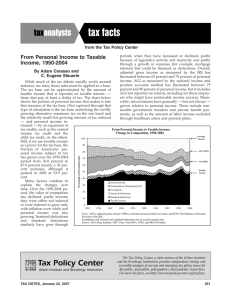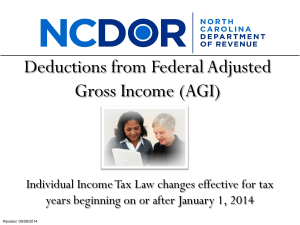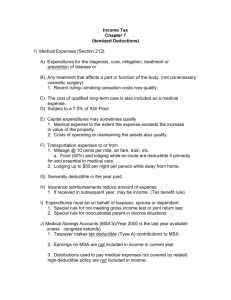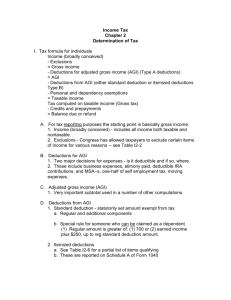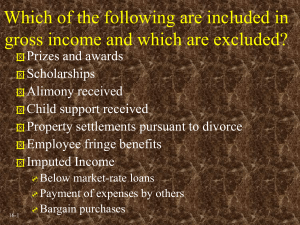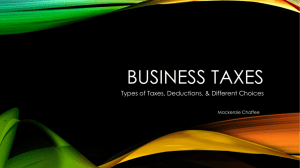Chapter 14, 16 & 17
advertisement
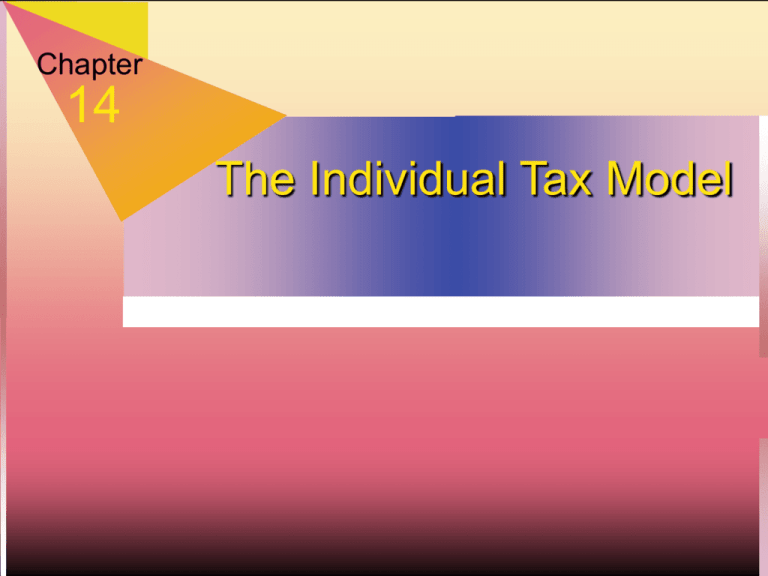
Chapter 14 The Individual Tax Model Filing Status - Married If married on the last day of the year: status must be either Married filing joint or Married filing separately. MFJ rates apply to Surviving Spouse widow or widower with a dependent child for two more years after death of spouse. MFS (married filing separately) rates are less favorable than single. Generally only used for separated couples or US citizens or residents married to a nonresident alien Filing Status - Unmarried Single is the default category for unmarried individuals (neither surviving spouse nor head of household). Head of household - maintain a home for either child (need not be dependent) dependent relative Taxable Income Computation Calculate total income totaling Line 22 on 1040. Calculate Adjusted Gross Income (AGI) on Line 37 of 1040. Subtract the greater of: itemized deductions or the standard deduction Subtract total exemptions Result is Taxable Income Individual Tax Model – Gross Income / Exclusions General Rule: Gross Income is “Broadly Conceived”: Includes all income subject to taxation unless specifically indicated as not taxable by law. Exclusions include: unrealized gains, gifts, inheritances, welfare type payments, many fringe benefits, returns of capital, Municipal Interest, some US Govt for higher education, life insurance proceeds. Scholarships - excludible if recipient is candidate for degree, amount received is not a payment for services, and is used to pay tuition, books, and other similar educational expenses Foreign earned Income (Sec. 911) - build U.S. Economy Exclude up to $100,800 of foreign earned income annually plus a housing allowance (exclusion cannot exceed earned income Individual must be a bona fide resident of the foreign country for an entire tax year or be in the foreign country for 11 mos in any 12 month period. Individual Tax Model: Special Income Inclusions Annuities: Amount not taxed: Inv. / Expected Return * Pymts Rec Deferred Compensation Plans: Defined Contribution Plans, Defined Benefit Plans - Qualified Retirement Plans Prizes and Awards - include FMV Social Security Benefits - up 85% may be taxed Unemployment compensation is taxable Alimony received is taxable / Child support is not includible but is not deductible either. Special Rules Dividends (cash and noncash) - FMV of prop received (subject to E& P provisions) Stock dividends generally not taxable Damages - personal (special rules) business damages not excludible. Discharge of indebtedness - generally includible. Business versus Investment Business activity Time and talent on regular basis Profit partially attributable to personal involvement Income is considered earned income Hobby losses only deductible to extent of hobby income – not a business activity Investment activity Passive role as owner of income-producing property Income is considered unearned income Losses on personal use assets are not deductible – gains from sale are treated as capital assets. Investments in Financial Assets Securities include: common and preferred stock savings accounts, CDs, notes, bonds Return on / Income from investment includes Interest (ordinary income) Dividends (special rules post May 2003) Reinvested dividends are still taxable but increase basis. gains (losses). Mutual funds may report ‘distributed’ capital gains/losses. These are still taxable but increase basis even if no cash received. Gains/Losses on Securities Realization requires a sale or exchange Gain/loss = Proceeds - adjusted basis Character is capital - time period matters Basis issues reinvested dividends increase basis. Sale of stock uses either specific ID or FIFO method of matching basis with sales. Mutual fund shares sold typically use an average basis. What to do with Capital Gains and Losses SHORT TERM asset held for <= 1 year – gains taxed as ordinary income LONG TERM asset held for > 1 year L/T Gains taxed at lower capital gains tax rate of 20% Net the gains and losses in each class (net ST, net LT, net 28%LT). Special rule for sale of principal residence Exclude gain up to the amount of statutory exclusion if home is principal residence 2 years out of 5 years ending on date of sale. Exclude only one gain every 2 years. Limits $500,000 MFJ, $250,000 other Deductions for Adjusted Gross Income and AGI Deductions for Adjusted Gross Income Trade/Business Exp from a Sole Proprietorship are reported on Schedule C / or for a rental property are recorded on schedule E Student Loan interest up to $2500 (Income limits apply) Self Employed Expenses: 50% of SE tax, percentage of health insurance premiums, Keogh and Simple retirement plans IRAs, Moving Expenses, Contributions to MSAs Penalty for early withdrawal of savings Result of Income less deductions for Adjusted Gross Income –is AGI (very key concept) - many deductions are a function of AGI (e.g., IRA deductions, medical expenses, charitable contributions) Many items of gross income are also a function of AGI Social Security Benefits, Passive Activity Losses Deductions from AGI: Standard Deduction or Itemized Deductions Standard Deduction Depends on filing status. For 2014/15: MFJ = $12,400/$12,600 MFS = $6,200/$6,300 HOH = $9,100 / $9,250 Single = $6,200/$6,300 Blind or aged (>=age 65) MJF, MFS = additional $1,200/$1,250 HOH or Single = additional $1,550 Take the higher of Standard Deduction or Itemized Deductions as a reduction of AGI in the computation of Taxable Income – Discussion of Itemized Deductions follows Itemized Deductions / Personal Losses - Chapter 17 Itemized deductions a special class of deductions that allow taxpayers to derive tax benefits from certain personal & investment expenditures Individuals deduct the greater of the standard deduction for his/her filing status or the total of his/her itemized deductions. About 1/3 of all TPs claim itemized deductions Itemized deductions are shown on Form 1040 Schedule A. Medical Expense Deduction Sec. 213 - qualified non-reimbursed medical expenses for a TP and dependents qualify for a deduction subject to a 10% of AGI floor (7.5% if over 65) - only 5% of TPs benefit Qualifying expenses include Medical insurance premiums / prescription drugs Medical treatment / Physical & Psychological treatment medical products, glasses, artificial limbs etc. Capital improvements - limited to excess over increase in home value due to the improvements. Capital improvements to remove structural barriers for physically handicapped - fully deductible. Cosmetic surgery if it results from disease, personal injury or congenital defects. No deduction allowed for: Elective cosmetic surgery Taxes Sec 164 - lists deductible taxes In general - only income taxes (other than Federal) and property taxes ad valorem taxes on investment and personal property are deductible. Taxes must be distinguished from assessments, fines & penalties which are not deductible. Taxes are only deductible when they are the taxpayers obligations. No deduction for paying another persons taxes. No deduction is someone else pays your taxes. 50% of SE tax is deductible, Sales tax are deductible if total is greater than income taxes paid to a particular state. Interest Sec 163 - certain types of interest paid or accrued by a taxpayer during the year is deductible Mortgage interest, some points, home equity interest or investment interest - are individual itemized deductions Investment interest expense- deductible to extent of net investment income ( Gross Inv. Inc - Inv. Exp.) Inv. Interest deduction not allowed if used to purchase tax exempt securities. Qualified Residence Interest indebtedness used to purchase, construct or improve the taxpayers residence 2 homes allowed -Int on debt up to $1 Million is ded.. Home equity interest limited to principal of 100K Point on new loan or improvement loan deductible when paid. Refinancing - amortized over loan life. Charitable Contributions Sec 170 - gifts to qualified charities is deductible Qualified charities: U.S. based organizations operated exclusively for religious, charitable, scientific, literary or educational purposes or for the prevention of cruelty to children or animals. Contribution amount reduced by value of any benefit received by the donor LTCG property = value is FMV No deduction allowed for contribution of services or rent free use of property. Contribution Limits LTCG property - limited to 30% of AGI Total contributions limited to 50% of AGI Excess contributions can be carried forward 5 years If contributing property, TP must be able to substantiate value. Must file form 8283 if noncash contributions > 500 Independent appraisal is required when a single item of donated property is valued in excess of $5,000. Casualty Losses / Miscellaneous Itemized Deductions Casualty losses - unreimbursed losses due to theft or casualty. Losses are reduced by $100 and 10% of AGI. Excess, if any is deductible as an itemized deduction. Misc. deductions subject to 2% of AGI limitation- (must exceed 2% of AGI to be deductible) Unreimbursed Employee Business Expenses - union dues, uniforms, business use of auto, job search, other prof. Dues Expenses for managing or safeguarding assets: safe deposit rental, investment advice, investment publications Tax determination expenses: Tax prep fees, legal representation in tax audit, legal and accounting fees for tax planning, appraisals for tax reporting Misc. deductions not subject to 2% limitation gambling losses to extent of gambling winnings unrecovered investments in annuities due to annuitants death. Exemptions Personal exemption for the taxpayer (2 for MFJ). If you are a dependent on someone else’s return, can you still claim yourself? Exemption = $3,950/$4,000 in 2014/15 for each personal or dependency exemption. Exemptions for Dependents Family member OR live in your home for entire year. You provide > 1/2 financial support Dependent’s gross income < exemption amount ($3,950 for 14) waived for child < 19 OR student-child<24 Dependent may not generally file a joint return. Dependent must be a U.S. citizen OR a resident of US, Mex, Canada Rich People Phase-out of itemized deductions – Repealed in 2010 – returned effective for 2013 – Haircut (reduction in allowed itemized deductions) = AGI – Threshold ($305,050/ $309/900 (2014/15) for MFJ) * 3%. Phase-out of exemptions – Repealed in 2010. Returned effective 1/1/2013. For our class assume if AGI is greater than $435,000 then no personal exemptions are allowed. If AGI < $435,000 allow full amount of exemptions. Tax on net investment income (dividends, interest, capital gains, net income on passive activities): 3.8% for individuals with income in excess of $200,000, MFJ in excess of $250,000 . Please know it exists but we will not compute the tax on our assignments for this course. Tax Credits A credit is a dollar for dollar reduction in the tax liability. A deduction only reduces the tax by the marginal tax rate associated with that deduction. Child Credit = $1,000 per child in 2014 Phases out for rich. Dependent care credit (child < 13 years old). Credit amount between 30% and 20% of child care costs depending on income range. Earned income credit. This is refundable - a transfer payment to working poor. Increases progressivity of tax rates. Credit is higher for taxpayers with children and phases out as income increases. Excess FICA withholding is refunded through a tax return claim. Tax Subsidies for Education Hope scholarship credit / American job opportunity cred - 1st 4 years of college. Max $2500 per year per student based on tuition/fees. Phase out for MFJ between $160-180K) Lifetime learning credit = 20% of tuition/fees: Max $5000 per year. Lifetime credit phase out begins $110- 130K for MFJ Education IRA - withdrawals spend on education are tax-free. Payment and Filing Requirements Taxes on wages are withheld each pay period. Estimated taxes are due on April 15, June 15, September 15, and January 15. Pay 90% of current year tax, 100% of prior year (or 110% of prior year AGI>$150,000). Tax return due 4/15, but may be extended to 10/15 (LAST DATE). Kiddie Tax Children under age 18 with unearned income greater than $2,000 are subject to kiddie tax The unearned income in excess of $2,000 is taxed at the parent’s highest marginal tax rate The residual taxable income is taxed at the child’s rate. What are the kiddie tax provisions designed to prevent? Wealth Transfer Tax System – Covered on last day of class. This is an excise tax system which is different from the income tax system. Gift, estate, and generation skipping transfer taxes The unified gift and estate tax is based on cumulative transfers over time (life + death). Current tax rate is 35% Gift Tax Remember, all receipts of gifts are excluded from INCOME taxation. We are now discussing GIFT taxation. Exclude $14,000 per year per donee from taxable gifts. No gift tax on gifts to spouse, charity, paying tuition or medical costs. Can treat gift by one spouse as made 1/2 by other spouse. Exclusion Lifetime exclusion $5,340,000 Income Tax Effects of Gifts Gift is not taxable income to donee. Donor’s adjusted basis in the property carries over to become the donor’s basis. exception - use FMV if less than adjusted basis After gift, any income derived from the property belongs to the donee. Estate Tax Taxed at unified estate and gift rate schedule FMV of estate is taxed Unlimited marital deduction Reduce estate by taxes, charity, administrative expenses. Income Tax Effect of Bequests Receipt of a bequest is not taxable income to heir. Basis = FMV at date of death = free income tax step-up in basis. (In 2010, wealthy estates generate carryover basis). Trade-off gift now at low basis, perhaps avoid some transfer tax keep and include in estate, but heirs get high basis
